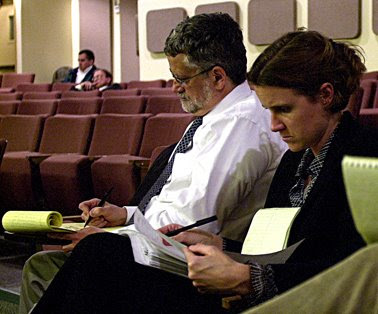What’s Wrong With This Picture?

All the media, bloggers included, seem to have jumped on the
RailRunner express show, including:
Journal North, Thursday, December 18, 2008, by Journal Staff Writers Kiera Hay and Phil Parker, "
All Aboard the ABQ-SF Rail Runner."
Journal, Thursday, December 18, 2008, by Journal Staff Writer Leslie Linthicum, "
One Joyful Ride Changed My Mind ."
Journal, Monday, December 22, 2008, by Journal Staff Writer Sean Olson, "
Delays force agency to add train for Sunday service to Santa Fe."
Only in New Mexico, Monday, December 15, 2008, by Jim Baca, "
Rail Runner."
Only in New Mexico, Friday, December 19, 2008, by Jim Baca, "
Rail Runner and Road Tax."
New Mexico Independent, Tuesday, December 16, 2008, by Trip Jennings, "
Guv takes valedictory lap on Rail Runner."
New Mexico Independent, Wednesday, December 17, 2008, by Trip Jennings, "
Rail Runner Express kicks off its public schedule today," "
Rail Runner sidetracked a bit with day one glitches."
New Mexico Independent, Wednesday, December 17, 2008, by Matthew Reichbach, "
Rail Runner snags another high profile rider."
Weekly Alibi, December 18 - 24, 2008, This Week's News/Opinion, by Marisa Demarco, "
The Northbound Train."
KRQE TV, Monday, December 15, 2008, "
Rail Runner trains beat
snowy I-25 Santa Fe service starts Wednesday."
KOB TV, Eyewitness News 4, Wednesday, December 17, 2008, "
Rail Runner makes inaugural trip to Santa Fe."
KOB TV, Eyewitness News 4, Saturday, December 20, 2008, "
Ridership overwhelms Rail Runner to Santa Fe."

Now I have an affinity for the rail; I like trains. It might be that when I was born, my parents lived in Alexandria, Va. next to the train yard. The constant sounds of trains being moved about a switchyard must have been my primary auditory sensation. We were also under the flight path for National Airport. Hence, the reason I also like aircraft.

I like trains even when I can't see them. When I hear a train whistle, I'll say, "There's a Train!"
I'm fascinated by all aspects of the rail industry.

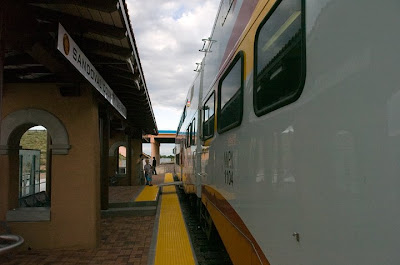
In the summer of 2006, the
Mid-Region Council of Governments’ RailRunner began the 18-mile run from Albuquerque to the north side of Bernalillo.
Later, the service was extended south to Belen.

When the original railroad came to New Mexico at the end of the 1870s, Bernalillo was the first choice for a rail yard. However, the cost of land became prohibitive, so the rail company moved 17 miles south.
The tale is told in an Aug. 1976, New Mexico Magazine article by John Sinclair, “The Place Where De Vargas Died,” that I helped illustrate. Sinclair called the demand by the then patron José Leandro Perea, the act, “…distinctive of as one of America’s first environmentalists, a man who didn’t like clatter and smoke, or gringos interfering in the affairs of a happy little Spanish village.”
An aside:
 Our Lady of Sorrows church in Bernalillo was slated for demolition after the 1972 Fiesta because a new church was opened. As a result of my picture, taken from across the Rio Grande, a group, including architects, who told me they were inspired to try to save and rehabilitate the old church. For more than 30 years, work has slowly progressed on the old building.
Our Lady of Sorrows church in Bernalillo was slated for demolition after the 1972 Fiesta because a new church was opened. As a result of my picture, taken from across the Rio Grande, a group, including architects, who told me they were inspired to try to save and rehabilitate the old church. For more than 30 years, work has slowly progressed on the old building.
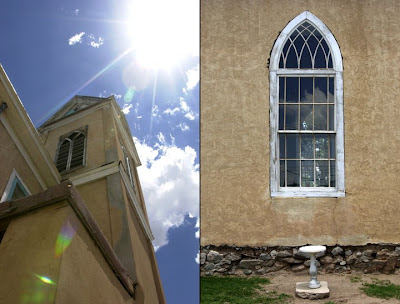
The planned railroad yard's move from Bernalillo was the impetus for the growth of the little town of Albuquerque. On April 6, 1880, the first train came through town. Later that month, on the 22nd, passenger service began. Carrying mail by stagecoaches was rendered obsolete.
AMTRAK took over passenger service through New Mexico from the Atchison, Topeka and Santa Fe in May, 1971.
Things didn’t appear to change right away; the Santa Fe’s equipment and personnel were used, as seen here, below, on the first day of official AMTRAK service. It didn’t look any different than the day before.

Mail was moved in the same way, on and off the first westbound AMTRAK through Albuquerque.

AMTRAK has run two scheduled passenger trains each day from Chicago to Los Angeles and back.
The idea of commuter train service in the Rio Grande valley has been kicked around for more than 35 years.

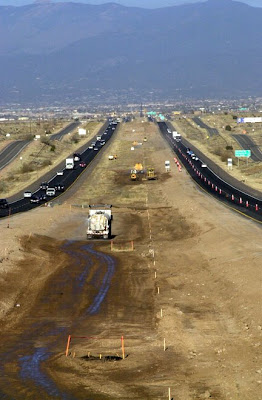
Over the past year, I have been to Santa Fe several times and watched the progress of the construction in putting down new track along Interstate Highway 25.
So what’s wrong with this picture?
I went to Santa Fe with my publisher/friend Harold Morgan Thursday for the “2009 pre-session Legislative Seminars and new members orientation.” We had considered riding the RailRunner. However, our timetable went into free floating, in part due to the weather. We decided to drive.

Along the way, we came upon a northbound train stopped on a siding.
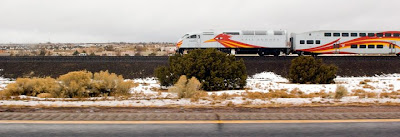
The southbound train was coming out of the City Different.
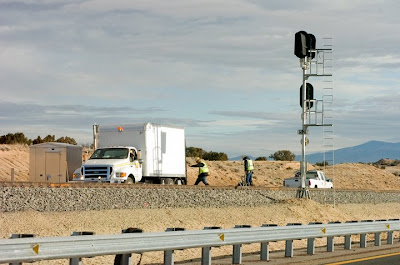
A couple of weeks ago, on the way to Santa Fe, to cover the Governor - Lt. Governor’s “press availability,” construction workers were making last-minute adjustments to the track and testing the signals.
All the effort apparently didn’t work out all the kinks.
The inaugural run went off without a hitch, but put more than one train on the track and the system seemed to have generated its own problems. Trains were late by more than an hour and a half from the scheduled arrival times.
The fault was blamed on signals between San Felipe and Santo Domingo Pueblos on the main line part of the route. A southbound train hit a cow on the San Felipe Pueblo, stopping the train for some time and delaying its arrival by more than an hour.

On the way back from the Legislature’s meetings, a mid-afternoon northbound train was on a different siding. The conductor was standing in the remnants of an earlier snowstorm. It is the sign of an anticipated extended delay.
Crews are known to get off of their trains when placed on a siding and having any kind of wait. Click to enlarge; note crewman in white shirt to right of freight train.
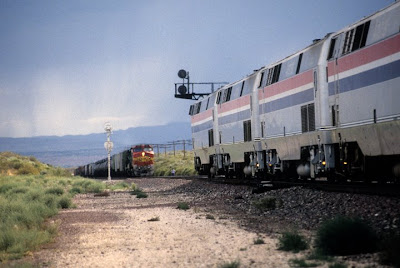
This eastbound Burlington Northern - Santa Fe freight crew dismounted while it waited for the westbound AMTRAK to pass, at Dalies junction, west of Belen on the main line. In excess of one hundred freight, and two passenger trains pass this point every day on one of the busiest train routes in the country.

Analysis:
Many are upset at the cost; $400 million, for the 100-mile RailRunner project.
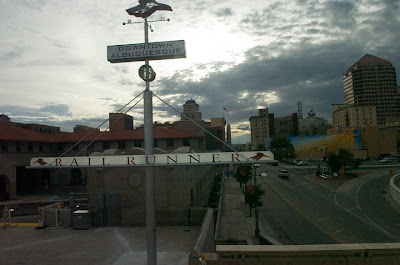
Such transportation projects are not self-sufficient. However, this project has been supported by tax initiatives, although the bond questions were put to voters only after the project was started.

Some argue that the money is poorly spent, pointing to the relatively low numbers of persons carried on the train versus the numbers who use cars.
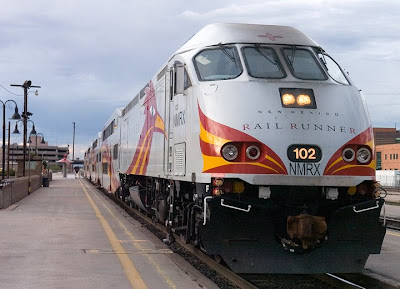
There are flaws in the argument:
The number of individual cars with single passengers on the road, while convenient, is extremely inefficient. In our car driven culture, the efficiency is seldom addressed.
Effective mass transit concepts are based on wide ranging networks that meet the needs of the public. Those needs must include timely, convenient, accessible and affordable service.
Former Albuquerque Mayor Jim Baca pointed out in his blog that there was not enough parking at the stations. Such a problem for the park and ride set defeats the purpose of getting people to use the train in the first place.
Road projects are not self-sustaining either. Gas taxes added at the pump don’t completely pay for road and bridge infrastructure.
Baca pointed out that Albuquerque’s ten-year transportation tax is due to expire shortly and questioned, “I can't understand why this deadline has crept up on the administration like this.” The administration of current Mayor Martin Chávez didn’t miss this deadline. To the contrary, his attempt to fund his modern trolley has been predicated on the continuation of the transportation tax.
Baca writes about the transportation tax having passed by 700 votes. He doesn’t speak about the effort he made to woo the Albuquerque Police Officers Association to not oppose this tax, as they had the public safety tax that they worked to defeat a couple years earlier. Baca did not understand why the APOA had opposed the first tax.

Albuquerque Police Officers Association negotiators met about the quarter percent Transportation Tax, on February 17, 1999, with Baca, center left, and his Chief Administrative Officer Lawrence Rael, right, who is now the Executive Director of the Mid-Region Council of Governments which runs the RailRunner. The cops, through the APOA, could have cared less about the transportation tax. The police had felt that Chávez was trying to manipulate them and the public by calling for the tax’s use to be for public safety.
Chávez continues to push for his trolley system, in part by claiming that all great cities have a trolley, light rail or subway system.
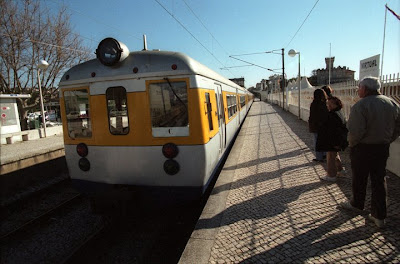
Looking at the capital of the poorest European Union country, Lisbon, Portugal, with a population density of 2.5 million in its metropolitan region; they have an intricate mass transit system.

A fundamental part of Lisbon's transportation system includes rails with: electrified trolleys, trams, a subway, and several commuter light rail operations, in addition to a bus system.
Chávez claims, in a current report published by the US Conference of Mayors, “
Ready to Go,” jobs and infrastructure projects
report, that he needs $90 million for Phase I of the Central Street car. It will create 500 jobs.
According to an article in the Albuquerque Journal, "
City's Wish List Is Fifth-Biggest," Chávez asked for $2.3 billion from President-elect Barak Obama’s newly proposed stimulus package.
A Forbes magazine article, “
The Obama Boomtowns." Ranks Albuquerque’s request was the fifth highest.
The other cities ahead of the Duke City asking for more money are: Miami, Sacramento, Calif., Philadelphia, and Los Angeles.
Miami has a Metrorail with 27 stations on a single line and a free Metromover on a downtown loop with 20 stations. It also has almost 900 buses on 91 routes; some that operate 24-hours a day.
Sacramento's population is smaller than Albuquerque's, but is situated in a broader metropolitan community of over two million people.

The Sacramento Regional Transit District has a light rail
system, above, with two branches and a downtown trackless trolley replica, below.
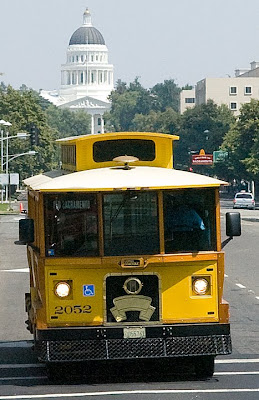
Sacramento 's RT has 32 million boarding passengers a year on 76 light rail cars; 277 buses, vans and trolleys.
Philadelphia's Southeastern Pennsylvania Transportation Authority serves a population of 3.9 million, with ridership of 325 million.
SEPT uses 2,664 vehicles, of which half are buses; the rest are, light rail, subway-elevated, regional rail, and paratransit vehicles.
Los Angeles has a large
system with 380,073,888 bus boardings. LA has five Metro rail
linesChávez
claims the amount is for $1,635,606,800 for 96 infrastructure projects that can be started right away creating almost 5,000 jobs.
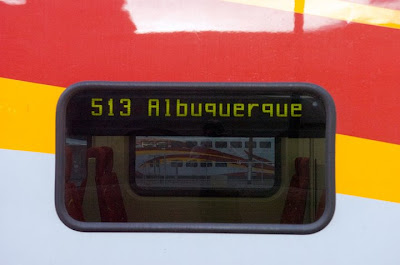
Though Albuquerque is
ranked 34, by city size, based on 2007 data, with population of 518,271, it can be easily argued to be a good city; but great is questionable. It certainly doesn't serve the population sizes of their economic rivals.

My Take
One might argue that starting projects without full public support by the legislature or local governmental bodies is the sign of leadership; while others might argue it's a sign of power politics, as usual. Both might be right.
There is a reality; the cost of driving to Santa Fe was substantially less than taking the train. The Rail Runner would have cost $8 per person for a day pass. The half tank of gas needed for the trip was four dollars less and we didn’t have to pay the downtown - parking garage at the main station, which is closest to us.
Cost alone is not the only factor. Once the RailRunner provides internet connection, there maybe an added benefit of being able to work while traveling.
Start up glitches have a way of working themselves out. Other problems, like a RailRunner Police Force with multiple jurisdictional authority, are only now being addressed. Such a force, represents a substantial cost. Security is a foreseeable issue. Political considerations of trying to expose all the costs, up front, might have dictated not addressing on-board security and to rely upon local law enforcement for protecting station parking lots and platforms. The decision is unconscionable for administrators and managers to wait more than two years to even come to a realization that policing is necessary.
I'm left with nagging questions:
Phase I of the Central Avenue Street Car is proposed to go from Nob Hill to the Biological Park, a distance of 4.59 miles. The construction cost is $28 million per mile or $128,520,000.
A couple of years ago, City Council shot down the trolley proposal. Now Chávez is asking Obama for $90 million for the same project. Was the original price grossly over calculated then, or is it radically under valued now?
The
RailRunner Project cost $400 million dollars. It included buying about 280 miles of existing BNSF mainline track from Belen to Trinidad, Colo. About 15 miles of new track was constructed from Waldo canyon to the Santa Fe spur. Existing Santa Fe Southern track will complete the trip to downtown Santa Fe.
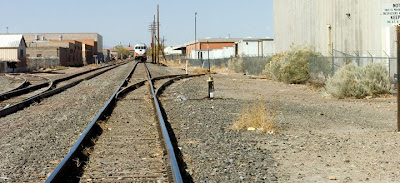
The total RailRunner line is a hundred miles. So why does less than five miles of lighter rail capacity of the Central Avenue Street Car cost almost a quarter of what the RailRunner did?



































